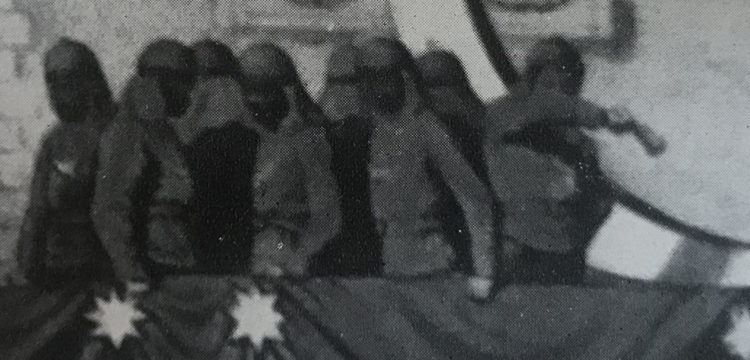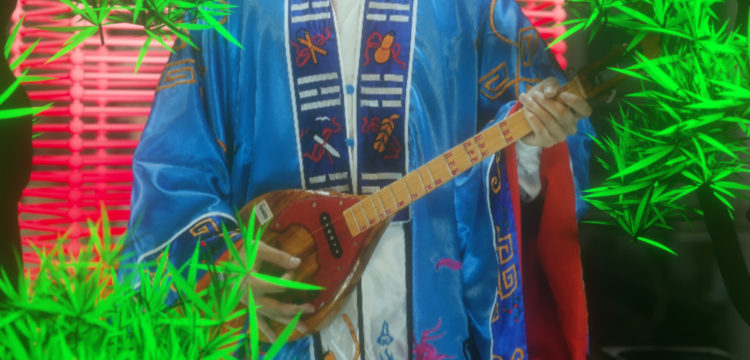That time Mike Cooper was in Ubin
Magical Thinking, Spirit Songs and Walking on Leaves in 2012
On the occasion of the release of Mike Cooper’s new album, a pearl from our archive, initially published on NERO Magazine, ISSUE 30, Autumn 2012, on Section 11 – A New Reportage. From May 6th until June 6th 2012 Mike Cooper has been invited as artist-in-residence on Pulau Ubin by The Artists Village (TAV) group based in Singapore
My fascination with islands originates from several sources in my youth, one of them is having to read the William Shakespeare play The Tempest as one of my final English Literature classes at school. In my travels I have visited many islands including those of Fiji, Tahiti, Hawaii, New Zealand, Thailand, Malaysia, Borneo, Hong Kong and Singapore.
“Be not afeard; the isle is full of noises,
Sounds, and sweet airs, that give delight and hurt not.
Sometimes a thousand twangling instruments
Will hum about mine ears; and sometime voices, …”
(William Shakespeare, The Tempest)
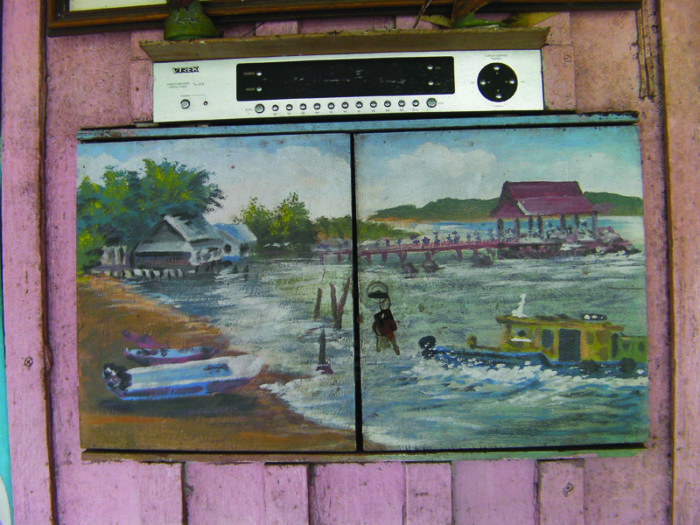
I spent one month on the island of Pulau Ubin near Singapore. My initial idea was to make a ‘sound map’ of the island. Places where I had visited and made field recordings which others could visit and perhaps have a similar listening experience. It turned into much more than that for me and I ended up making three short video films as well as an hour long audio soundscape of field recordings.
My artistic “work” and interests are many and diverse and among them is an interest in acoustic ecology sometimes called “ecoacoustics” or “soundscape studies;” described (by Murray Shafer author of The Tuning Of The World, 1997) as “the relationship, mediated through sound, between living beings and their environment.” It is a discipline that analyzes how we interpret and are affected by natural and artificial sounds around us. Shafer also suggests that people “echo the soundscape in language and music.” With this statement in mind I have for many years been incorporating my field recordings into my live, mostly improvised, music concerts. Anthropologist/Musicologist and friend Steve Feld coined the name “Echo-Muse-Ecologist” which I quite like and feel an affinity with.
For me nature sounds are “music” and are a “composition” put together spontaneously and with purpose by my avian, insect, animal and vegetable friends. Many composers these days use nature sounds or “field recordings” as source material for digital manipulation to make compositions. Personally I see this as a form of exploitation, preferring instead to collaborate rather than colonize.
Northern Beach Barrier
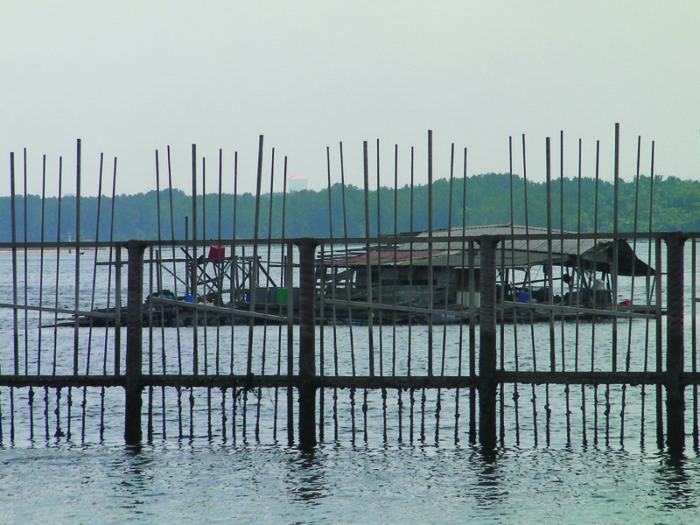
Singapore has very strict immigration laws and is separated from Malaysia by just a few kilometers of water. In fact close enough for an elephant to swim across, which is what happened in the 1991. I could never work out if this beach barrier was to deter more landings by animals, or people or to keep rubbish away from the beach. The Japanese crossed this stretch of water in rubber boats from Malaysia in a matter of minutes during World War 2 when they invaded and occupied Singapore.
“Over the sea, arc lamps crackle
Across the beach, barbed wire lays looped
Cold sharp and abandoned
To rust on this beach
The old world the other side
The migrant dropped, exhausted
Voiceless tired men far from your love
His soul snatched or maybe just left behind.”
(The Migrants Song-Mike Cooper)
Sunset Beach
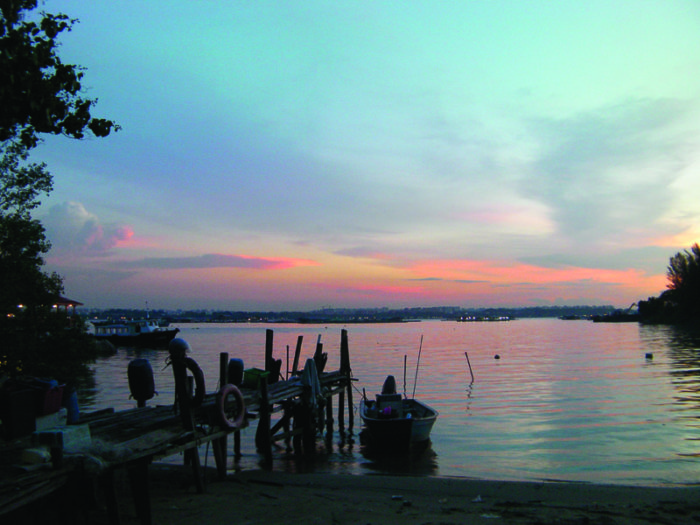
The island is never completely silent. At night and in the daytime the sound level from insects can be as loud as heavy traffic in the city (85 decibels) and because there is no electricity on the island there is always the sound of a generator coming from somewhere. The sound of traffic on nearby Singapore island travels across the water as does the sound of the ferry boats bringing groups of tourists laughing and shouting to cycle noisily around. Aircraft crossing over the island, landing and taking off from Chiangi airport mixes with big tropical thunder storms rattling the sky, mostly at night, and heavy rain falling on the tin roof of the artists house. Animals, ghosts from the nearby Chinese cemetery, nesting birds or rats all move noisily through the roof above me as I try to sleep beneath my mosquito net . “Eugene” our resident frog croaks loudly throughout the night in the empty room next door .
“Approaching zero, thinner and thinner
Transparent pure light.
He has a few words; well chosen words.
Went to the movies, from the east.
Loved films and sleep.
Fragments he saw; kept to believe
metaphor, signs and symbols.
Design dreams of light.
He found a sound.
The electric tram, the roar of the waterfall
A green wet smudge
The sound grew louder
A revenant abstraction
A lightning bunker sound
A spluttering roar, a whining ringing.”
(Torch Song – Mike Cooper)
It was on Lamma lsland dose to Hong Kong- where I did a short residency as a sound artist some years ago that I experienced the “magical thinking”even my most rational friends in Hong Kong indulged in. The small beach where I was staying, and where I played an outdoor concert, had a smaii Taoist shrine nearby on a rock dose to the sea. My friend, a sound and conceptual artist and arts organizer, visited the shrine with me. She entered, said a short prayer and lit incense as an offering, asking for good weather during my performance.
Shrines on Pulau Ubin
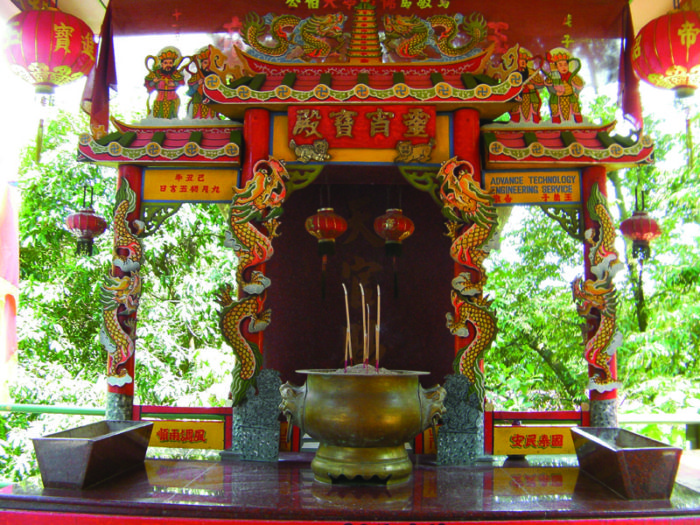
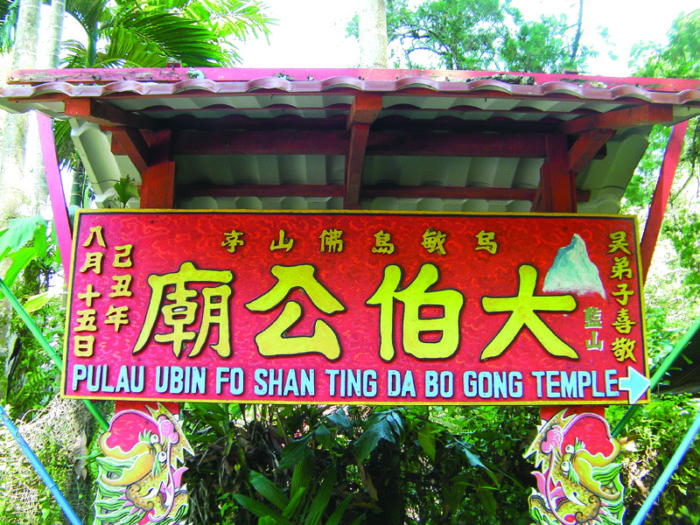
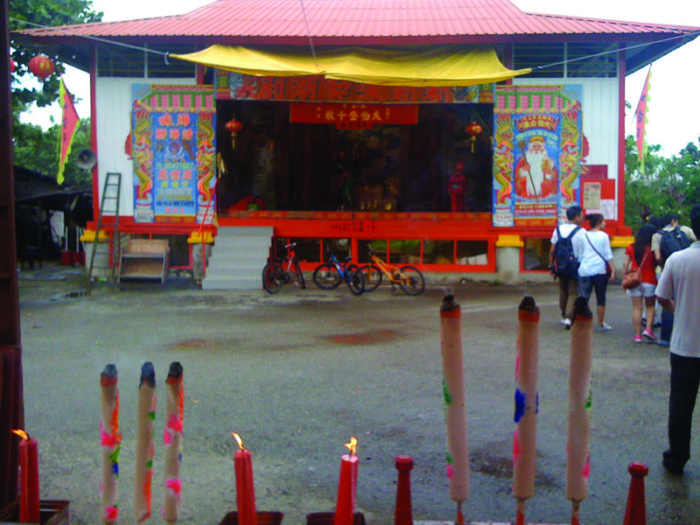
Ting Da Bo Gong temple is famous for its Chinese Opera presentations and as I entered the main square down near the ferry jetty this afternoon for some lunch I see it is full with a “mirror version” or replica of the Ting Da Bo Gong temple which is on a hill close by. There are Chinese Opera singers and musicians practising with drums, cymbals and Chinese one string violins. On the main stage a Chinese rock band from Singapore is setting up and will later play Chinese pop songs. They all practise together all at the same time. It will be a concert to raise funds for the temple later in the evening.
The majority of the shrines on Pulau Ubin are Chinese Taoist. A philosophical and religious tradition that emphasizes living in harmony with the Tao. The Tao meaning “way,” “path” or “principle.” Taoist schools traditionally show reverence for the poet Lao-zi, immortals or ancestors, along with a variety of divination and exorcism rituals, and practices for achieving ecstasy, longevity or immortality. Taoism tends to emphasize wu wei (action through non-action), “naturalness,” simplicity, spontaneity, and the The Three Treasures: compassion, moderation, and humility.
“Wu wei… literally means ‘no action,’ but not in the sense of sitting all day like a dead tree stump… rather it means avoiding action that is not spontaneous… eschewing artfully calculated action and every activity stemming from a profit motive.”
(John Blofield, Taoism)
In ancient Taoist texts, wu-wei is associated with water through its yielding nature—it asserts that if one places their will in harmony with the natural universe a potentially harmful interference can be avoided. To follow Tao is to recognise the inner harmony and balance in all living things.
Leaf Installations
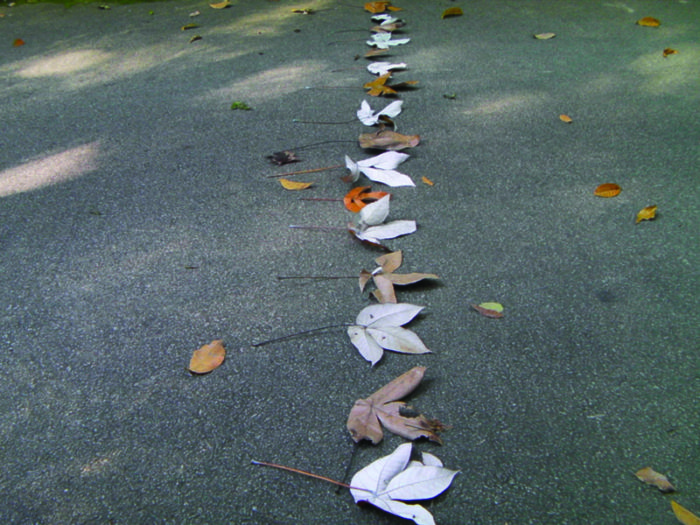
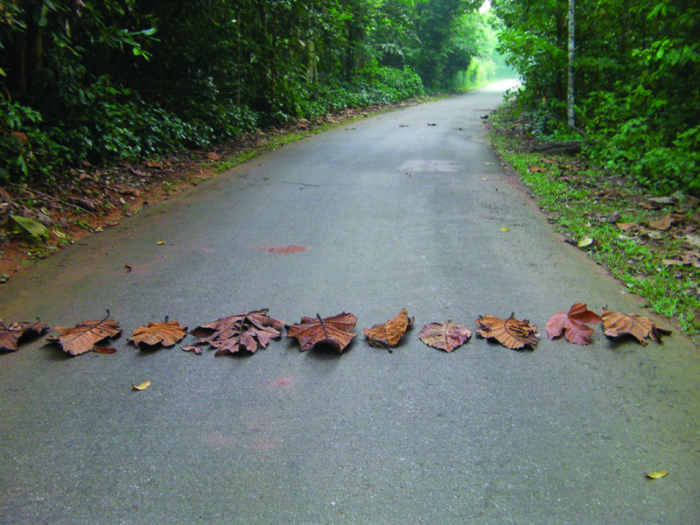
I made several “leaf installations” on the roads in Ubin as “artificial borders” as I walked each day which I documented as photographs or video. They were usually quickly destroyed by people passing over them on bicycles or the wind or rain. An impermanence in tune with local custom.
At night the soundscape and the visual aspect changes dramatically from that of the daytime. Humans have limited night vision and the forest takes on an ominous and perhaps, to some, threatening aspect with unexpected and unknown sounds issuing at unknown distance as big dead leaves, tropical fruit, coconuts and sometimes whole trees crash to the ground. The daytime birds are replaced by less frequent sounds of night birds and a whole different acoustic world of insect sounds take over. The sound of strange attractors at work.
I made several recordings of walking on dry leaves, one in particular around the German Girl Shrine (see below). There is an expression that the people in West Papua use which is “walking on the leaves of trees” which means traveling great distances at high speed—supernaturally!!!
“They sing / ‘we will be, we will be free’ /
and walk on the leaves of trees/ we will walk on the leaves of trees..”
(from Spirit Song – Mike Cooper)
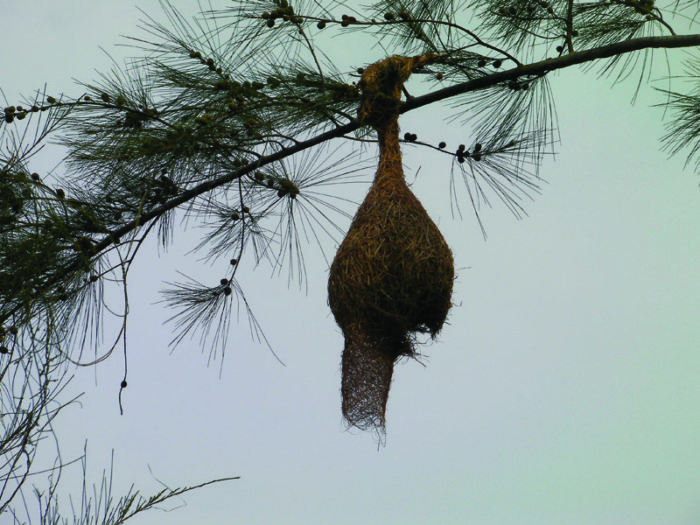
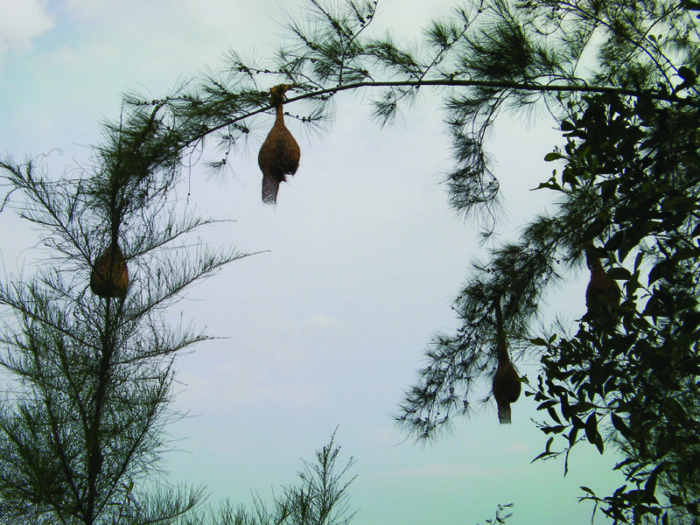
The German Girl Shrine
The German Girl Shrine is located 4km by road from the main jetty near Ketam Quarry. It is far from the usual visitor trail except for those who come specifically to visit this shrine. A peaceful and contemplative place. Nearby a species of bird unknown to me have built extraordinary basket like hanging nests in a single tree. As I approached the tree to photograph it one of the birds pretends to be injured and drops to the ground singing in front of me trying to distract me and lure me away from the nests.
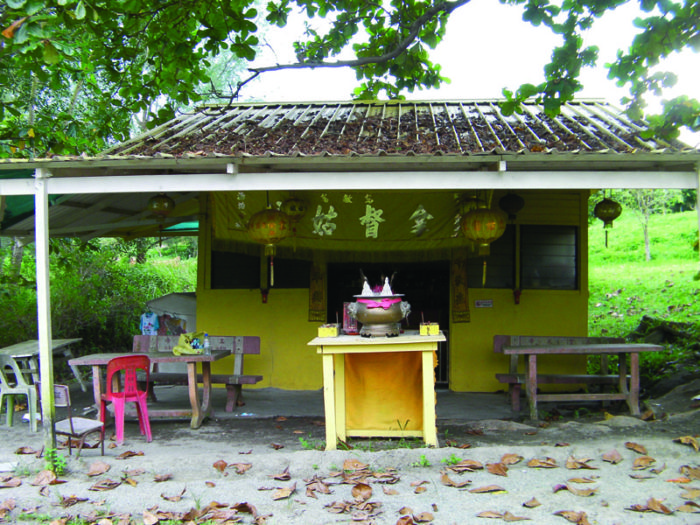
The ambient sound around the German girls shrine is one of almost complete silence apart from a few singing birds and wind blowing through the long grass in the surrounding area. A large Assam or Tamarind tree hovers over the shrine and showers the ground with its dead dried leaves. I decided to record a “leaf-walking” piece here—(hopefully accompanied by the spirit of the German girl perhaps?) with my portable digital recorder. I walk slowly around the site and record my boots crushing the dried leaves. The sound of me “walking in Ubin” is a prominent feature of my sound recordings.
The story of the German Girl Shrine is that a coffee plantation manager and his family lived near this site in the early 20th century. At the end of World War One British soldiers arrived to intern her parents but the daughter escaped through the back door. She allegedly fell to her death into a quarry nearby. Her corpse was discovered by plantation laborers, who threw sand over her body and offered prayers, flowers and incense as a gesture of good will each time they passed her. Eventually, a group of Chinese quarry workers took her remains to the crest of the quarry’s hill and gave her a proper burial.
In 1974, the grave was exhumed, to make way for quarry excavation work, and relocated to its present spot. Her remains were transferred in an expensive Jiangsu burial urn, bought for the ritual of ash-transferring by the quarry company Aik Hwa. Today the urn, a heavy white jar, sits upright on a dust-caked altar strewn with an eerie collection of feminine tributes: hair brushes, nail polish, powder, Safflower Oil, Florida Water, and the odd tubes of Revlon lipstick and red packets rolled into tokens used for casting lottery numbers. A red fortune tellers table and chair sit quietly in another corner. Hanging on one side are baby clothes and a collection of children’s toys. Being a foreign girl, the shrine was built with a barbie sized doll as the centre piece with an accompanying rosary as she was Christian.
Not long ago someone decided to open the urn to see if her remains were really inside. There was nothing. This fact however has not deterred people from visiting, praying and showing respect. One regular visitor said “Ah, but that’s exactly why she’s a deity. She’s invisible but everywhere, like Tua Pek Kong. Her power is omnipresent.”
Another small shrine is built at the side to honour Orr Ki, (Black Mole) who also drowned nearby several years ago. Worshippers believed his death was pre-destined in order to be the German girls helper and guardian. The recent addition of the children’s clothing and shoes next to the shrine are a form of spirit child worship, which is also practiced in Thailand (Guman Thong) and Malaysia (Toyol).
The mixture of Christian cross, Na Tuks, Malaysian Chinese deities and child spirit worship at this shrine is a fascinating fusion of Chinese and other folk religions. There is also a shrine for the two “Hell Guard Brothers” whose job it is to drag wandering spirits back to hell.
My Na Tuk Kong Shrine
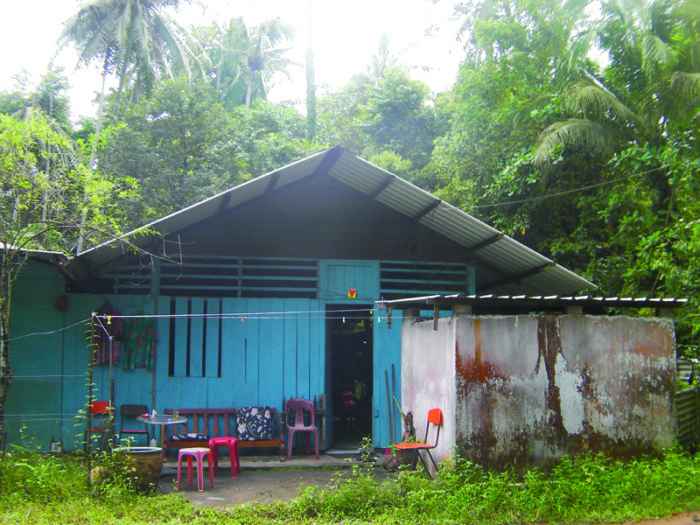
At night sometimes I sat outside for hours in the dark just listening. I often experienced something which I would compared to swimming underwater in the Ocean. Of being inside an organic alien medium sometimes quite threatening and oppressive.
I began to perceive the forest and its sounds as one complete, unified, thing, similar as I said before, to the underwater Ocean world, which is a complete and separate world from our normal daytime on-land experience. I was experiencing an “Oceanic Feeling–Like”-maybe? An impressive experience and epiphany.
“Buzzing heat / annoying large / another animal / drowning presumably…”
(Buzzing Heat – Mike Cooper)
Shrines are built at places where people have encounters. The shrine structure, which is usually painted yellow, might appear empty except for a piece of granite rock. Asian religion is nature worship and the Datos spirits are said to reside in trees, stones and even the spirits of water wells.
Na Tuk Kong are said to be supernatural beings who are resident in a particular area. Na Tuks are remnants of a pre-Islamic animist Malay religion and I made my own Na Tuk Kong from a palm tree branch, owl feather, flowers, leaves and empty soft drinks cans with incense and two coconuts and named it Kelapa Kepala or Coconut Head a term I had heard used in Bali to describe someone who is stupid.
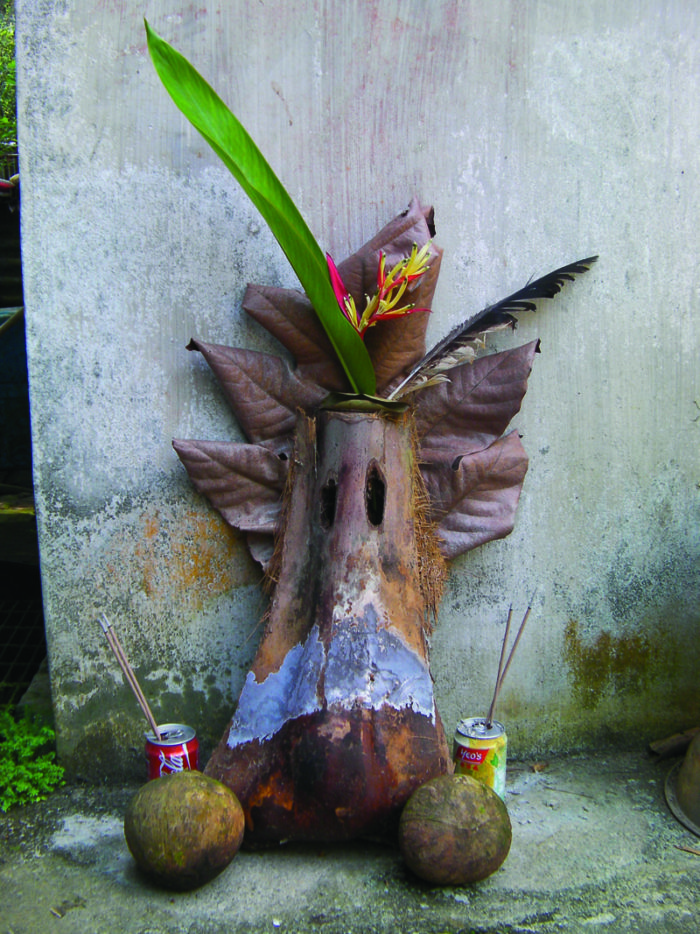
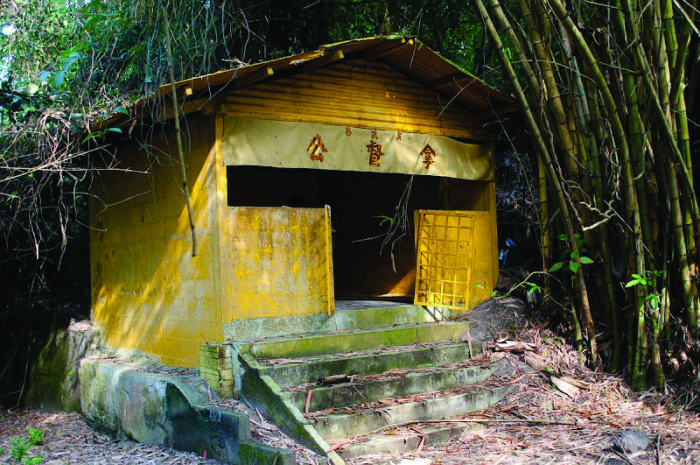
“I sat outside the house under the overhanging roof in the pouring rain. The sound of the rain and the thunder is sometimes frighteningly loud. From inside the house I can just about hear Yuzuru Maeda my fellow artist in residence practising her Indian Sarod. She is singing softly to herself and playing a song she remembers she liked from sometime in the past. It is Harry Neilson’s song Coconut.”
“Put the lime in the coconut and drink ’em both together,
Put the lime in the coconut, and you’ll feel better,
Put the lime in the coconut and drink ’em bot’ up,
Put the lime in the coconut and call me in the morning.”




